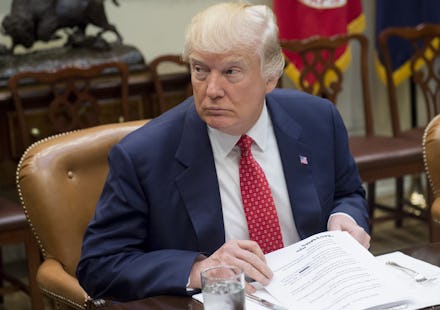Here's a look at US defense spending from the Ronald Reagan era to Donald Trump

The United States spends more on defense than the next seven highest-spending countries combined, and it appears that President Donald Trump is about to spend a whole lot more. But sometimes numbers don't tell the whole story.
In his address to Congress, Trump said, "I am sending the Congress a budget that ... calls for one of the largest increases in national defense spending in American history."
That increase is reported to be $54 billion. Trump's usual hyperbole notwithstanding — it is neither the largest increase nor the largest defense budget in U.S. history, according to previous federal budgets, which are a matter of public record (though some programs and agencies have classified budgets).
The budget can be measured in different ways. For example: As NBC reported, Trump's $603 billion budget is for "defense-related spending," not just spending by the Pentagon.
If Obama's 2018 budget was measured the same way, there is just a 3.1% difference between them. It is possible, however, to identify some trends.
The Reagan years
Ronald Reagan took office at the height of the Cold War. At the time, the U.S. maintained an arsenal of over 20,000 nuclear weapons, and in 1981 had 2,082,560 active-duty military personnel .
By the time he left office in 1989, that number had increased slightly to 2,138,213. Reagan also presided over an increase in defense spending to 5.7% of U.S. gross domestic product.
After the collapse of the Soviet Union, the defense budget started a long march downward.
The Bush-Clinton era
The George H.W. Bush and Bill Clinton years saw a decrease in defense spending of over 33%. However, there were minor upticks based on particular events: The 1991 Persian Gulf War added $9 billion in spending, and the 1994 intervention in the Balkans resulted in another unexpected increase of $15 billion. The post-Cold War "peace dividend" effectively ended on 9/11.
In 2001, U.S. troop strength was 1,385,116 — more than 35% lower than it was in 1988. After 9/11, the defense budget increased. The 2002 defense budget was just over $402 billion. By 2003 it increased to $468 billion, and in 2004, with the Iraq War in full swing, it was up to $494 billion.
But the George W. Bush administration did some tricky accounting: It didn't include the Iraq War as part of the regular defense budget.
The Obama years
The Obama administration changed the accounting, integrating Iraq-related expenditures into the overall defense budget. Thus the defense budget grew to $729 billion in 2012.
The U.S. defense budget has been decreasing for the last few years, but both Trump and Obama planned on an increase for fiscal year 2018.
The issue is not the increase or the amount; the U.S. has real defense needs. Some aspects of the military need modernization, and military spending drives employment in manufacturing and in small businesses near military installation.
Defense spending has brought us innovations like the internet, GPS, stealth planes and that cool swarm of drones at Lady Gaga's Super Bowl halftime show.
Trump's State Department gamble
The problem is that Trump's increase in defense spending is combined with a massive cut to the State Department. This cut could have serious impacts on our national security. They will increase both the reliance on hard power and the likelihood that such power will be needed. This may be why over 120 retired Military leaders have signed a letter opposing cuts to the State Department.
The U.S. can afford to spend massive amounts of money on defense. In 2015, defense spending was just 3.73% of GDP. Numbers are meaningless without context.
The context for this risky budget can be summarized in one word: Trump.